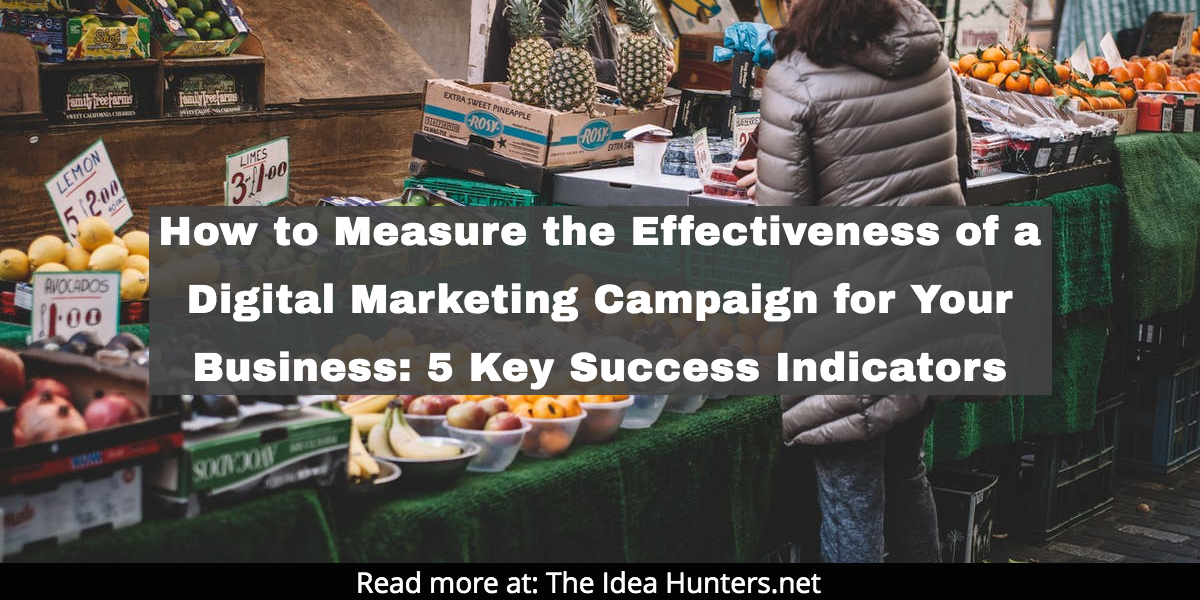
Most businesses these days use digital marketing campaigns featuring social media posts and online ads to help promote their company and increase sales.
Typically, a business would partner with a digital marketing agency that specializes in creating customized online advertising campaigns targeting their main user demographic.
The goal of investing in digital marketing is to generate consistent and steady growth in sales and business profitability.
However, it’s not always the case to see an immediate uptick in sales overnight following the launch of a digital marketing campaign.
That’s why business owners and marketers should pay close attention to five key metrics that provide an in-depth look into just how effective (or ineffective) a digital marketing campaign is performing.
While there are hundreds of different terms and metrics that can be examined in a digital marketing campaign, the most popular Return On Investment (ROI) indicators for business owners to examine first are:
- Impressions
- Click-Through-Rate
- Engagements
- Email Newsletter Subscribers
- Results
This data can provide further information on what digital marketing campaign strategies need to be revised, eliminated, or further invested into heavily.
How well is your digital marketing campaign performing?
The 5 Key Indicators for Success
1. Impressions
These are the actual number of views of your digital marketing campaign advertisement, such as a sponsored post on social media or a pay-per-click ad on search engine results.
While not always the sole indicator of how well a campaign is running, the number of impressions does show how well your ad is reaching your intended audience.
2. Click-Through-Rate
These are the actual number of clicks onto your digital ad from those interested in learning more information about your offer.
While click-through-rate (CTR) is also not a sole indicator of a digital marketing campaign’s success (i.e. not everyone who clicks will ultimately become a customer), it does reveal information on the effectiveness of your ad copy and images used.
The CTR is calculated by dividing the number of clicks by the number of impressions.
For example, if your ad was clicked on 5 times from a total number of 100 impressions, the CTR would be 5%.
Click-through-rate is useful because it can help determine whether your messaging matches what the consumer is actually searching for and how well it resonates with your intended audience.
The higher the CTR, the more users are finding your ad to be relevant. On the other hand, the lower the CTR, the less they are finding it to be relevant.
Generally speaking, a higher CTR means more engagement (more on that below), which generally leads to more quality conversions.
3. Engagements
From a social media and online advertising standpoint, engagement is a measure of the public shares, likes (or dislikes), and comments on a digital ad.
Historically, engagement is considered a common metric when evaluating social media performance. However, a high level of engagement does not necessarily translate into a high volume of sales.
4. Email Newsletter Subscribers
Many digital marketing campaigns drive traffic back to a business Website or blog.
If your Website offers an email newsletter (and it absolutely should) to promote special offers, highlight valuable content relevant to your audience, and get into your customer inboxes on a regular basis, then it makes sense you would see an increase in subscribers when digital marketing campaigns are run.
The reason why email marketing is such an effective method for building your customer base is simple.
While a social media post can easily be missed in a cluttered newsfeed, the chances of having your email be seen are much higher, due to the fact that most people check their emails at least once a day or more.
And while some people may not choose to purchase something immediately, if you provide consistent value in your newsletter with useful content and stay in front of people over the long term, the chances of them ultimately becoming a regular customer of yours will likely increase.
5. Results
The final key success indicator of a digital marketing campaign for your business is the actual result of these efforts.
Depending on the nature and intent of the digital marketing campaign, results can translate into things like an increase in store and Website traffic, more phone call inquiries, and higher sales revenue generated.
While a customer can result from a number of different efforts, such as word-of-mouth or your business location, seeing a positive growth in results during and after a digital marketing campaign can be a good indicator of how well your online advertising efforts are working for you.
Conclusion
These five key indicators are a good jumping-off point for any business owner to examine when determining how effective a digital marketing campaign is working for you on social media, search engines, and other Websites.
While some forms of traditional media like print ads and signage can make it difficult to track their effectiveness, digital marketing on popular sites like Google, YouTube, Instagram, Twitter, LinkedIn, Pinterest, and Facebook allow for business owners to access more advanced analytics.
This makes it possible to see how well campaigns are performing and where your online advertising budget should be spent to maximize ROI.
You can get an in-depth look into your company’s Web presence and access several useful tools to help you see what customers are finding about your business by downloading your free online business visibility report from my digital marketing agency. Click here to get your free report.
About James K. Kim
I am a former archery technician turned freelance digital marketer. I help people build profitable businesses online.
You can learn more about how to build a profitable online business at JamesKKimMarketing.com.
In my free time I enjoy the ancient sport of archery, sport crossbow target shooting, deep sea fishing, day hiking, recreational kayaking, high intensity weight training, ice hockey, and outdoor cooking.
Let's connect on social media:
Facebook • Twitter • Linkedin • Youtube • Pinterest • Instagram •








